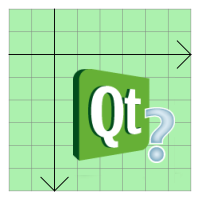QGraphicsPixmapItem¶
Synopsis¶
Functions¶
- def offset ()
- def pixmap ()
- def setOffset (offset)
- def setOffset (x, y)
- def setPixmap (pixmap)
- def setShapeMode (mode)
- def setTransformationMode (mode)
- def shapeMode ()
- def transformationMode ()
Detailed Description¶
The PySide.QtGui.QGraphicsPixmapItem class provides a pixmap item that you can add to a PySide.QtGui.QGraphicsScene .
To set the item’s pixmap, pass a PySide.QtGui.QPixmap to PySide.QtGui.QGraphicsPixmapItem ‘s constructor, or call the PySide.QtGui.QGraphicsPixmapItem.setPixmap() function. The PySide.QtGui.QGraphicsPixmapItem.pixmap() function returns the current pixmap.
PySide.QtGui.QGraphicsPixmapItem uses pixmap’s optional alpha mask to provide a reasonable implementation of PySide.QtGui.QGraphicsPixmapItem.boundingRect() , PySide.QtGui.QGraphicsPixmapItem.shape() , and PySide.QtGui.QGraphicsPixmapItem.contains() .

The pixmap is drawn at the item’s (0, 0) coordinate, as returned by PySide.QtGui.QGraphicsPixmapItem.offset() . You can change the drawing offset by calling PySide.QtGui.QGraphicsPixmapItem.setOffset() .
You can set the pixmap’s transformation mode by calling PySide.QtGui.QGraphicsPixmapItem.setTransformationMode() . By default, Qt.FastTransformation is used, which provides fast, non-smooth scaling. Qt.SmoothTransformation enables QPainter.SmoothPixmapTransform on the painter, and the quality depends on the platform and viewport. The result is usually not as good as calling QPixmap::scale() directly. Call PySide.QtGui.QGraphicsPixmapItem.transformationMode() to get the current transformation mode for the item.
- class PySide.QtGui.QGraphicsPixmapItem([parent=None[, scene=None]])¶
- class PySide.QtGui.QGraphicsPixmapItem(pixmap[, parent=None[, scene=None]])
Parameters: - scene – PySide.QtGui.QGraphicsScene
- parent – PySide.QtGui.QGraphicsItem
- pixmap – PySide.QtGui.QPixmap
- PySide.QtGui.QGraphicsPixmapItem.ShapeMode¶
This enum describes how PySide.QtGui.QGraphicsPixmapItem calculates its shape and opaque area.
The default value is MaskShape .
Constant Description QGraphicsPixmapItem.MaskShape The shape is determined by calling QPixmap.mask() . This shape includes only the opaque pixels of the pixmap. Because the shape is more complex, however, it can be slower than the other modes, and uses more memory. QGraphicsPixmapItem.BoundingRectShape The shape is determined by tracing the outline of the pixmap. This is the fastest shape mode, but it does not take into account any transparent areas on the pixmap. QGraphicsPixmapItem.HeuristicMaskShape The shape is determine by calling QPixmap.createHeuristicMask() . The performance and memory consumption is similar to MaskShape .
- PySide.QtGui.QGraphicsPixmapItem.offset()¶
Return type: PySide.QtCore.QPointF Returns the pixmap item’s offset , which defines the point of the top-left corner of the pixmap, in local coordinates.
- PySide.QtGui.QGraphicsPixmapItem.pixmap()¶
Return type: PySide.QtGui.QPixmap Returns the item’s pixmap, or an invalid PySide.QtGui.QPixmap if no pixmap has been set.
- PySide.QtGui.QGraphicsPixmapItem.setOffset(x, y)¶
Parameters: - x – PySide.QtCore.qreal
- y – PySide.QtCore.qreal
This convenience function is equivalent to calling setOffset( PySide.QtCore.QPointF (x , y )).
- PySide.QtGui.QGraphicsPixmapItem.setOffset(offset)
Parameters: offset – PySide.QtCore.QPointF Sets the pixmap item’s offset to offset . PySide.QtGui.QGraphicsPixmapItem will draw its pixmap using offset for its top-left corner.
- PySide.QtGui.QGraphicsPixmapItem.setPixmap(pixmap)¶
Parameters: pixmap – PySide.QtGui.QPixmap Sets the item’s pixmap to pixmap .
- PySide.QtGui.QGraphicsPixmapItem.setShapeMode(mode)¶
Parameters: mode – PySide.QtGui.QGraphicsPixmapItem.ShapeMode Sets the item’s shape mode to mode . The shape mode describes how PySide.QtGui.QGraphicsPixmapItem calculates its shape. The default mode is MaskShape .
See also
PySide.QtGui.QGraphicsPixmapItem.shapeMode() QGraphicsPixmapItem.ShapeMode
- PySide.QtGui.QGraphicsPixmapItem.setTransformationMode(mode)¶
Parameters: mode – PySide.QtCore.Qt.TransformationMode
- PySide.QtGui.QGraphicsPixmapItem.shapeMode()¶
Return type: PySide.QtGui.QGraphicsPixmapItem.ShapeMode Returns the item’s shape mode. The shape mode describes how PySide.QtGui.QGraphicsPixmapItem calculates its shape. The default mode is MaskShape .
See also
PySide.QtGui.QGraphicsPixmapItem.setShapeMode() QGraphicsPixmapItem.ShapeMode
- PySide.QtGui.QGraphicsPixmapItem.transformationMode()¶
Return type: PySide.QtCore.Qt.TransformationMode Returns the transformation mode of the pixmap. The default mode is Qt.FastTransformation , which provides quick transformation with no smoothing.




